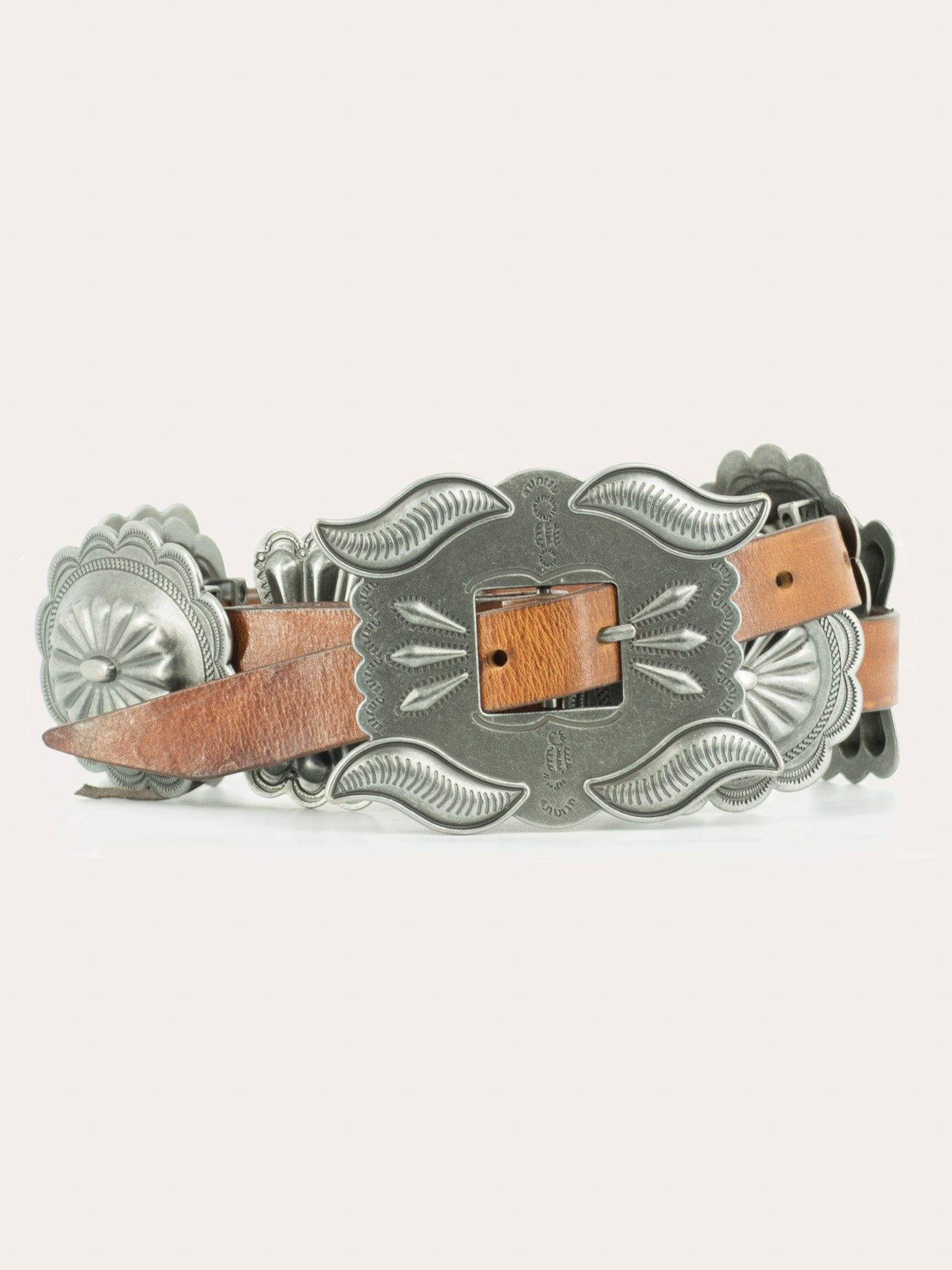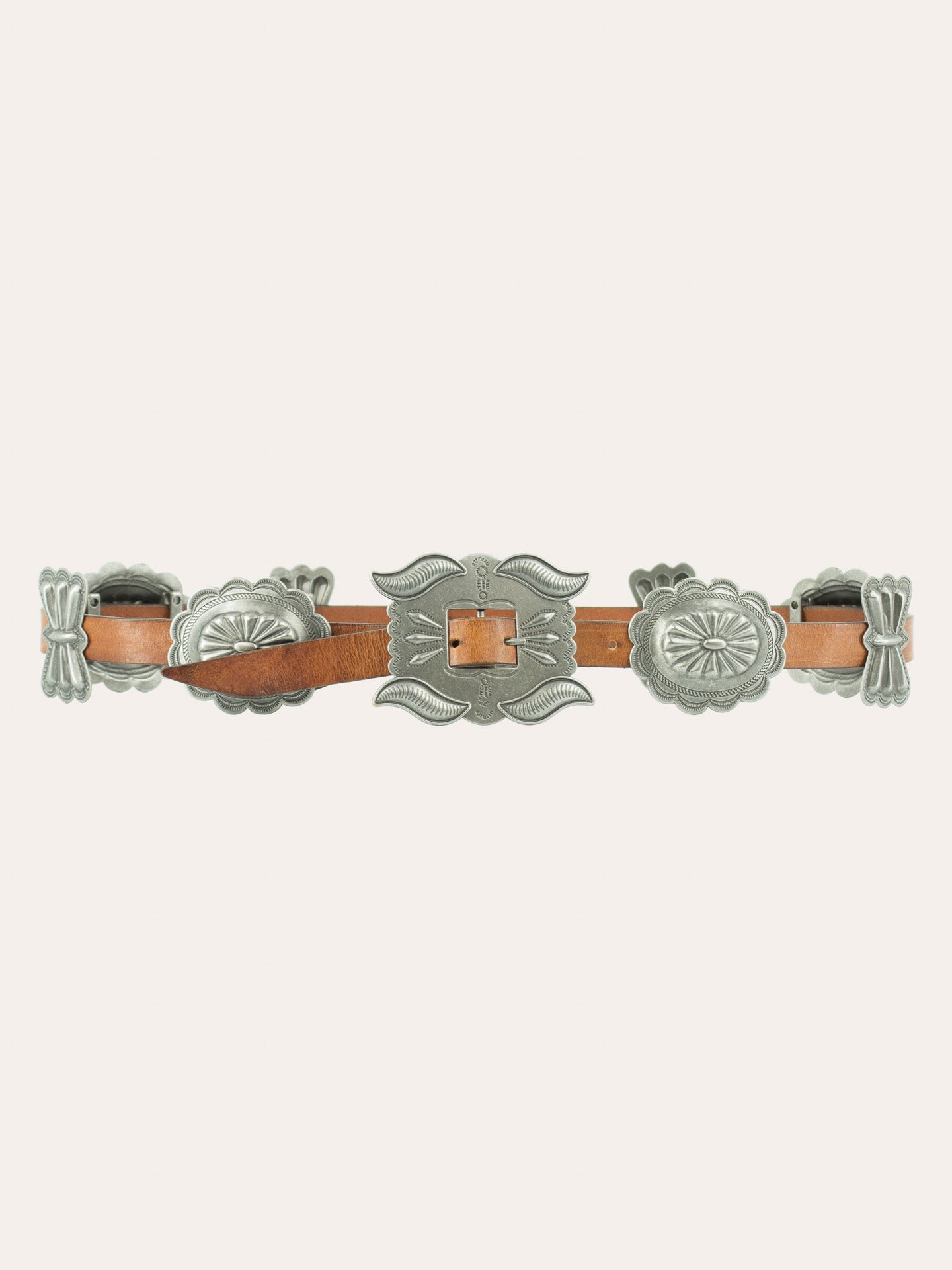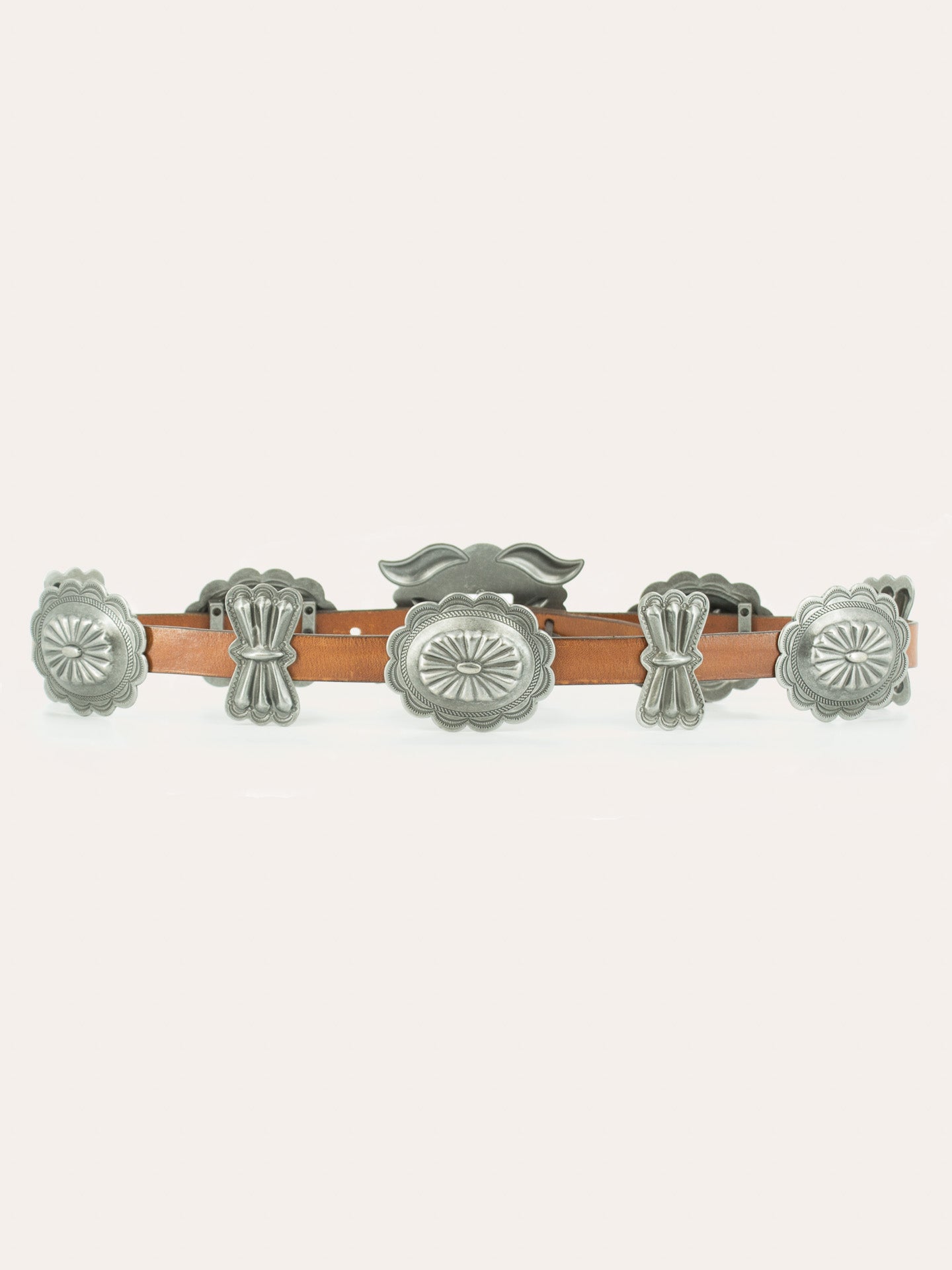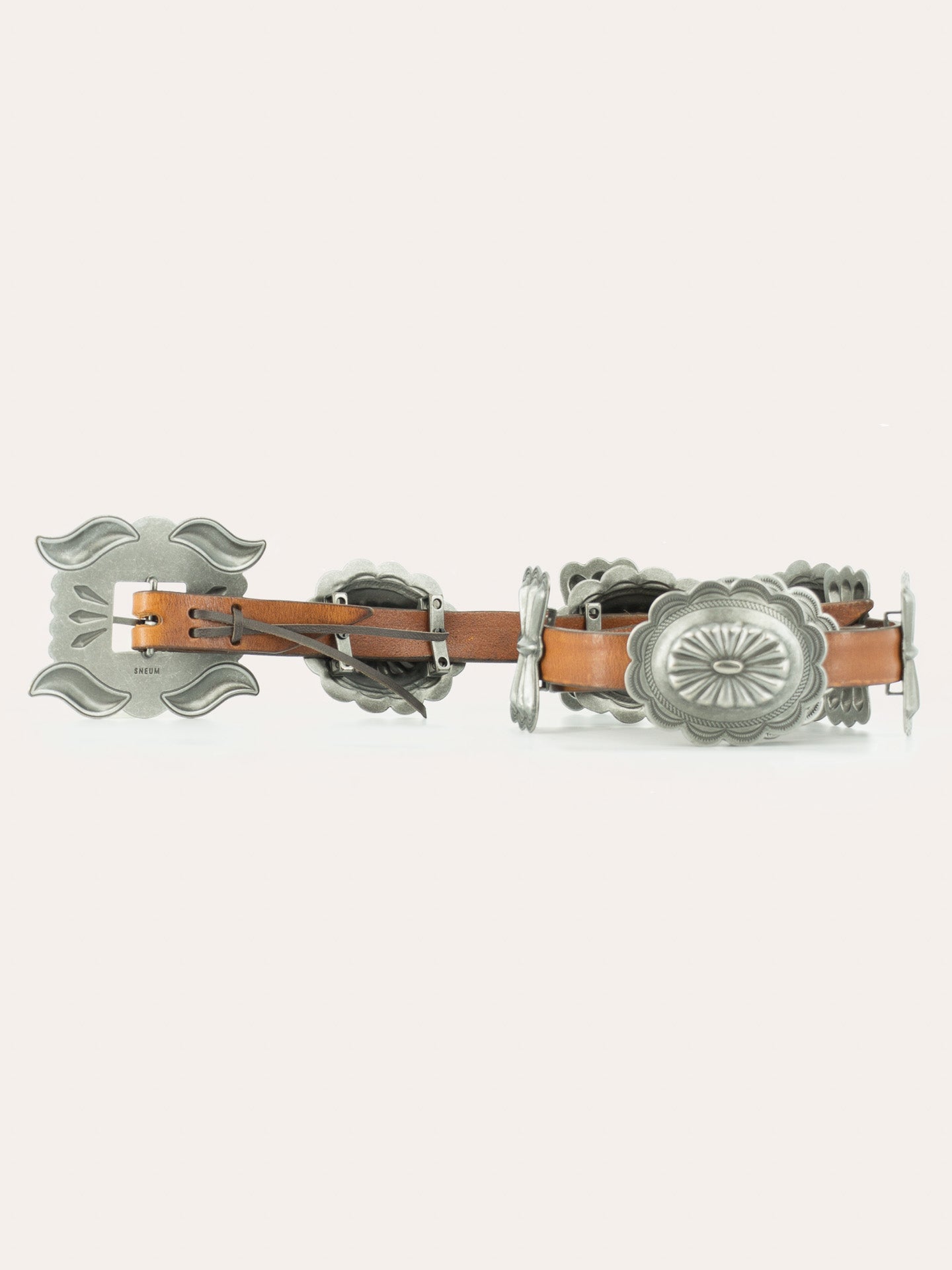A breif history of the concho-belt
The Concho Belt: A Historical and Cultural Analysis
The Concho belt, an iconic piece of Native American craftsmanship, has deep cultural and historical roots that span across various indigenous groups of the Southwestern United States. Its origins and evolution reflect a complex interplay of influences from Spanish settlers, Native American tribes, and the broader material culture of the American West. This article explores the history, development, and cultural significance of the Concho belt, particularly among the Navajo, Zuni, and Hopi peoples, as well as its transformation from a utilitarian object into a decorative item of fashion and status.
Origins and Early Influences
The word "Concho" is believed to be derived from the Spanish term "concha," meaning seashell, which describes the round or oval silver disks that characterize these belts. The earliest conchos were likely influenced by the shell-like appearance of silver ornaments used in horse tack, including bridles and saddles (Lawrence, 1992). Conchos were also found on other items, such as bolo ties, chaps, and jewelry, and were originally crafted from melted silver dollars. These disks were commonly used to adorn horse gear, symbolizing both wealth and status among the early settlers and Native populations in the region.
While the Concho belt is frequently attributed to the Navajo (Diné) and Zuni tribes, the design’s history is more complex, reflecting the blending of Spanish, Mexican, and Native American cultural elements. Spanish colonizers, who introduced silverwork to the Americas in the 16th century, likely played a pivotal role in the development of the Concho belt (Weil, 1993). The Navajo, who later became skilled silversmiths, borrowed elements from both Spanish metalworking techniques and the Southern Plains Indian hair ornaments known as hair plates (Schaffer, 1986). These influences combined to form the foundation of the Concho belt design, which has since become an integral part of Native American cultural expression.
Development and Phases of the Concho Belt
First Phase (Late 1860s to 1880s)
The earliest Concho belts were made by Navajo silversmiths in the late 1860s, a period when silver dollars were melted down and hammered into round, shell-like disks. These conchos were simple in design, featuring scalloped edges and diamond-shaped cutouts through which leather belts were threaded (Smith, 1998). Known as the "First Phase," this style of Concho belt was functional yet elegant, lacking the more elaborate designs seen in later periods. A significant figure in this early phase was the Navajo silversmith Arsidi Chon, often credited with creating the first Southwest American Indian Concho belt (Weil, 1993).
Second Phase (1890s to Early 1900s)
As Navajo silversmithing techniques advanced, a second phase of Concho belt design emerged in the 1890s. During this period, silversmiths began soldering silver straps or copper bars across the back of each concho, allowing the leather belt to be threaded behind the disk, thus enabling the entire front of the concho to be decorated. This technique allowed for more intricate designs, often incorporating repoussé and stamp work (George-Warren, 2001). The Second Phase Concho belts are considered more ornate, with increasingly sophisticated decorative elements.
Third Phase (Early 1900s to 1930s)
The Third Phase of Concho belt development, which began in the early 1900s, introduced several new design elements. The most notable innovation was the addition of "butterflies" or smaller, bow-shaped conchos placed between the larger disks (Smith, 1998). This period also saw the introduction of turquoise stones as a prominent decorative element. By the 1930s, copper had largely replaced silver as the material for the backstraps, as it was more readily available and less expensive than silver (Lawrence, 1992). These innovations helped to further differentiate Concho belts from other forms of Native American silverwork, solidifying their role as a unique form of cultural expression.
Cultural Significance and Modern Evolution
The Concho belt, once a symbol of Native American craftsmanship and identity, gradually made its way into the broader cultural landscape of the United States, particularly during the mid-20th century. Its adoption by high-profile rock and roll figures, such as Jim Morrison of The Doors, played a pivotal role in transforming the Concho belt from a piece of Southwestern tribal wear into a statement of counterculture rebellion.
Rock and Roll’s Adoption of the Concho Belt
In the late 1960s and early 1970s, Jim Morrison popularized the Concho belt as part of his distinctive rock star image. Often seen performing in his leather pants paired with a silver-studded Concho belt, Morrison's style became iconic, symbolizing both the rugged individualism of the American West and the rebellious ethos of rock and roll (Schaffer, 1986). His use of the belt in both casual and performance settings exemplified how Western wear crossed over into the mainstream, especially within the countercultural movements of the 1960s.
Other musicians followed suit, incorporating the Concho belt into their wardrobes. Janis Joplin, who embraced bohemian styles, and Jimi Hendrix, known for his eclectic and flamboyant fashion sense, were also seen wearing variations of the Concho belt during performances and public appearances. The belt’s fusion of indigenous craftsmanship and Western aesthetics resonated with the fashion trends of the 1960s and 1970s, where individualism and breaking from tradition were key themes (Weil, 1993).
By the late 20th century, designers like Ralph Lauren had introduced the Concho belt to the world of high fashion, where it found new life as a luxury accessory. Western-inspired apparel became a recurring motif in fashion shows and high-end collections, ensuring that the Concho belt remained both relevant and revered (George-Warren, 2001).
Conclusion
The Concho belt is more than just a decorative accessory; it is a powerful symbol of Native American culture and identity. From its origins in the late 19th century to its evolution into a modern fashion item, the Concho belt reflects the dynamic interplay between tradition and innovation in Native American craftsmanship. Its enduring appeal lies in its ability to blend practicality with intricate design, making it a treasured item both within Native communities and beyond.
References
- George-Warren, H. (2001). How the West Was Worn. New York: Harry N. Abrams.
- Lawrence, M. (1992). Utility Meets Fashion: The Evolution of the Western Shirt. Journal of American Fashion History, 14(2), 50-58.
- Schaffer, C. (1986). Western Wear: The American Cowboy Icon. New York: Outback Publications.
- Smith, A. (1998). Ranchwear in the American West. Chicago: Western Heritage Press.
- Weil, J. (1993). The Story Behind the Snap: A Ranchwear Evolution. Denver: Rockmount Publishing.
sneum.com
Navajo inspired Concho leather belt
Share




